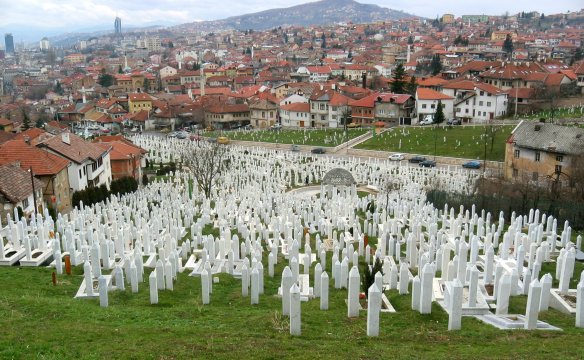The Dayton agreement ended the war. But with children from different ethnic groups unable to attend school together in many places, its intentions concerning reconciliation have unfortunately not been realized.

Martyrs’ memorial cemetery Kovači in Sarajevo. Photo: Michael Büker
“Of course I don’t need good grades in Bosnian when I’ve got good grades in English,” says a 13-year-old to his father in Sarajevo. The boy, who usually does well at school and has consistently good grades, has this year done slightly worse than usual in Bosnian, which is his mother tongue. His father is concerned. “But, why don’t you need good grades in Bosnian?” asks the father, with some astonishment. His son is quick to provide an explanation: “I won’t live here when I’m grown up. I’ll have to go somewhere else to find a job. For that it’s more important to know English than Bosnian.”
Youth unemployment
The father, who tells me this story at a café in Sarajevo, gives a slightly irritated laugh and rolls his eyes. “What should I say to him? After all, the boy is completely right,” he says, with a mixture of sorrow and pride in his son’s political instincts. The 13-year-old has understood that the coming generation in Bosnia has little to look forward to when it comes to jobs. According to the World Bank, the country has the world’s highest youth unemployment. This gloomy statistic has remained stable at around 60% for several years.
20 years since the peace agreement
14 December marked the 20th anniversary of the signing of the peace agreement that ended the Bosnian War. Although it was signed in Paris, the agreement was negotiated in Dayton, in the United States. In Bosnian and international circles, the agreement is referred to simply as “Dayton”. No longer simply a town in the state of Ohio, the word Dayton has taken on a new meaning, an alternative name for the Bosnian constitution.
A new generation of Bosnians has grown up on Dayton’s terms, which gives us good reason to examine more closely how this agreement has worked. The Bosnian War, which lasted from 1992–1995, was characterized by the forced “population transfer” of ethnic groups, who were also terrorized, massacred and exposed to such ferocious attacks that the map of Bosnia was redrawn.
The warfare, which was described as ethnic cleansing, was complex and difficult to deal with for the many peace negotiators and international actors that with very varying degrees of commitment, and success, attempted to persuade the parties to end the war and violence.
Unfortunate consequences
The Dayton agreement was reached as a compromise between the Bosnian, Croation and Serbian political leaderships. It assured all three groups balanced representation, even giving a right of veto in matters that were of particular significance for the respective ethnic groups.
Even though this compromise succeeded in ending the war and bloodshed, it has had a number of unfortunate consequences. The Dayton agreement cemented the policy of ethnic cleansing: today Bosnia is divided into two entities, Republika Srpska and the Federation of Bosnia and Herzegovina. Republika Srpska is dominated by Serbs, while Croats dominate those areas of the Federation that are close to the border with Croatia. The remainder of Bosnia, including the capital Sarajevo, is becoming more and more dominated by Bosniaks (the term used to refer to the country’s Muslim population).
It is now difficult to detect the inter-ethnic co-existence that was formerly a feature of Bosnia, and that was a source of pride for many people before the war. In addition, the Dayton agreement included a discriminatory constitution, whereby people who do not define themselves as belonging to one of three ethnic groups – Bosniak, Croat or Serb – are not eligible to hold political office. Citizens of Bosnia with inter-ethnic identities, as well as Jews, Roma and other minorities, also have no place in Bosnian politics, either symbolically or in practice.
Found guilty of ethnic discrimination
In 2009, the European Court of Human Rights ruled that Bosnia was guilty of ethnic discrimination, but little has happened to follow up this judgment. The Dayton agreement also facilitated the creation of a complex educational system, under which schools, universities and colleges are just as divided as the constitution.
Despite countless initiatives linked to peace and reconciliation at both political and civil society levels, the school system has contributed to promoting ethnic divisions through both its structure and curricula. Schools are segregated in many areas: Bosniaks go to one school and Serbs or Croats go to another. Alternatively, children from the different ethnic groups may attend the same school, but at different times, so that they do not share the same school day. In addition, children from different ethnic groups follow different curricula in key subjects such as languages and history.
The reason this situation can continue is that the Dayton agreement gave significant powers to decentralized levels of government. This has allowed free rein for the adoption of different ethnic educational policies.
Not a well-functioning state
The Dayton agreement ended the war and it is important to hold on to that fact. But its goals of comprehensive reconciliation and the establishment of a well-functioning state have not been realized.
There have been countless attempts to find shared arenas for inter-ethnic fraternization and reconciliation, with varying degrees of success. Something that has been successful, however, is an initiative to introduce shared teaching sessions at specific schools in English and computer studies. Norway has supported much of this work, which has been implemented by NGOs.
These lessons have sparked enthusiasm among both pupils and parents. But it was hardly the objective that the knowledge gained should be used as a springboard for leaving Bosnia, rather than for rebuilding the country.
- This text was published in Norwegian at Ytring 13 December 2015: “Bosnia 20 år etter“
- Translation from Norwegian: Fidotext